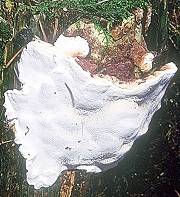Summary
Summary

The aims of this project were to optimise ways of controlling the fungal pathogen, Heterobasidion annosum, and minimise the use of chemical pesticides wherever possible.
Heterobasidion annosum (formerly called Fomes annosus) is a pathogenic fungus which kills the roots and rots the heartwood of most commercially grown conifer species. The pathogen gains entry to a crop, predominantly conifer species, when spores land on freshly created stumps. It then grows down into the root system and transfers across into the roots of adjacent trees, or a newly re-planted crop.
Research objectives
- Investigate whether treatments can be targeted to areas where the risks from the disease are highest
- Investigate biological control methods on pine and spruce
- Retain relevant EU and UK permits to continue use of two stump treatment agents
- Examine whether chemical thinning of larch and pine affects vulnerability to Heterobasidion root and butt rot.
Results so far
Disease risk assessment
The stumps of pine (Pinus species), Douglas fir (Pseudotsuga menziesii) and larch (Larix spp.) should always be treated using a chemical or, in the case of pine, chemical or biological control agent. We now know that the risk of serious disease in spruce (Picea spp.) species varies with soil type and climate. Our Disease Risk Assessment System shows that the greatest threat from this fungus comes on sites with well drained soils and relatively mild climates, whilst the risks are lowest on upland sites dominated by wet peats
Biological control
Forest Research manufactures a biological control agent, PG Suspension, against Heterobasidion annosum. It contains spores of another fungus, Phlebiopsis gigantea, and is very successful in controlling the pathogen in the predominantly pine forests of East Anglia. It is available to anyone harvesting pine, and is a practicable alternative to chemical treatment with urea.
PG Suspension is currently only licensed for use on pine species, but experiments are under way to see whether it, and a similar Scandinavian product, Rotstop®, are effective on spruce species as well. Preliminary results show that spore concentrations in the product would have to be greatly increased to make it effective on other species.
Pesticide legislation
All plant protection products are periodically reviewed across the European Union. The Forestry Commission is the permit holder for the biological agent, PG Suspension, and the chemical agent, urea. Both products are under review at the moment and the Forestry Commission has submitted information on both treatment agents for review by the EU and the UK pesticides authority – Chemicals Regulation Directorate.
Heterobasidion annosum and chemical thinning
Experiments are currently under way to see whether novel chemical thinning methods could be used to defoliate larch trees to try to slow or even prevent the spread of the pathogen, Phytophthora ramorum. Chemical thinning can, however, sometimes increase infection of trees by H. annosum, and this is being monitored.
Status
Disease risk assessment models are constantly being refined as further data are collected. An update will be available when the new edition of ‘Reducing Pesticide Use in Forestry’ is released.
Experimentation looking at biological control on spruce is ongoing and reviewed at regular intervals.
Pesticides re-registration requirements are amended regularly, and we aim to submit information to the relevant bodies if and when required.
Research into novel chemical thinning methods and impacts on Heterobasidion annosum began in 2014 and was due to conclude in late 2016.
Related resources (Recent publications)
Willoughby et al., (2004). Reducing pesticide use in forestry. Forestry Commission
Contact
Funders and partners
Research on stump treatment and associated pesticide registration requirements have been funded by the Forestry Commission, Scottish Forestry (formerly Forestry Commission Scotland), and Forestry & Land Scotland (formerly Forest Enterprise Scotland).
Forestry authorities’ policy
Both the research and the associated ongoing tasks relating to pesticide registration are crucial to the sustainability of much of the UK’s conifer forests and protection of the wider forest ecosystems. The country forestry authorities in the UK aim to increase the availability and uptake of PG Suspension, and we strongly support their drive to adopt an integrated pest management (IPM) approach wherever possible, to reduce the reliance on pesticides.
